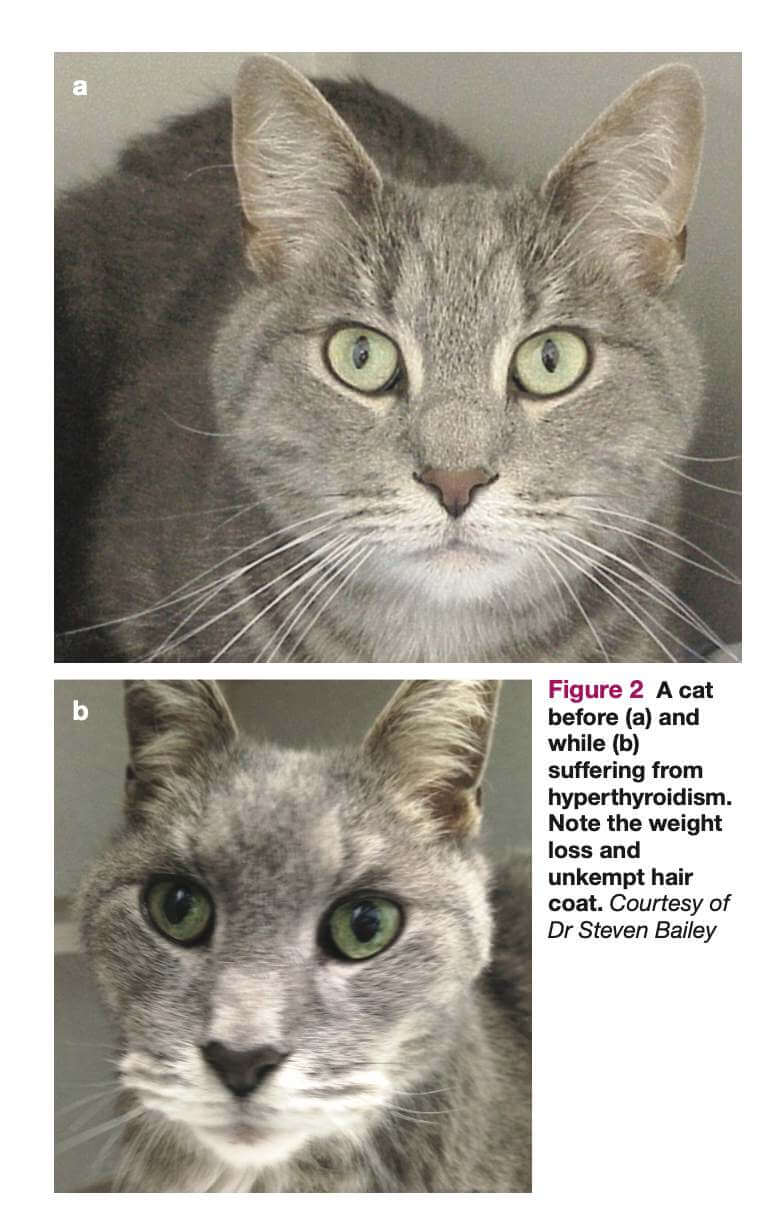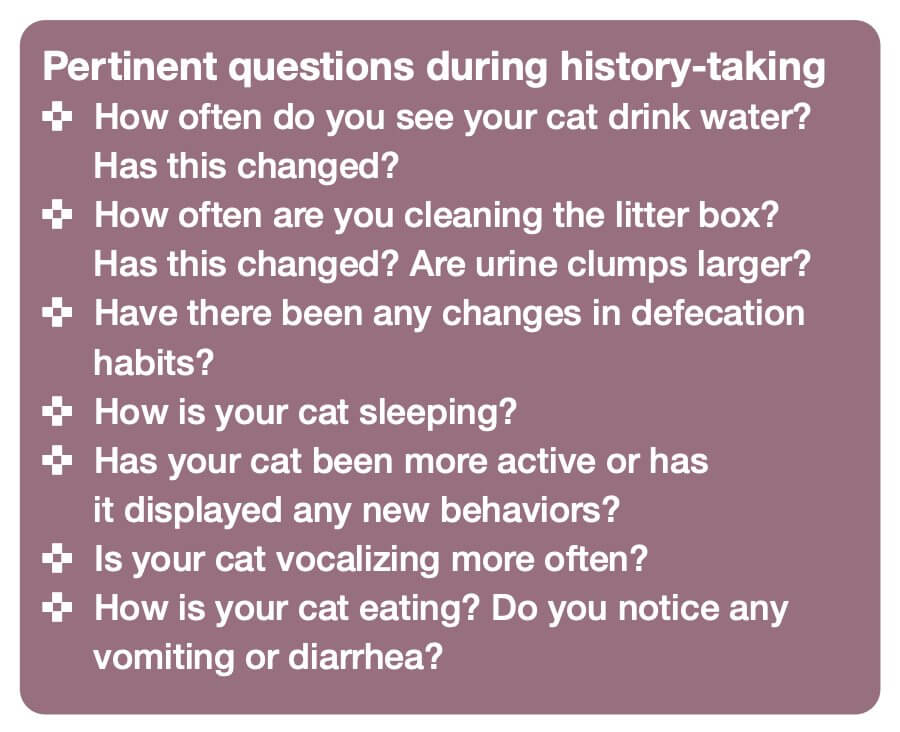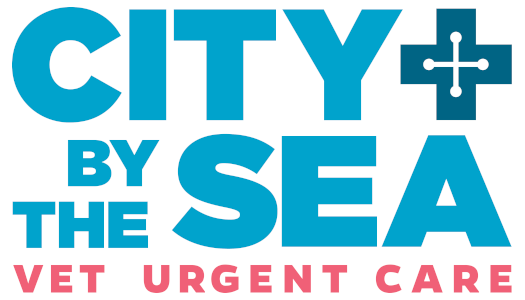
For today’s blog we take a deeper dive into a pretty common disease primarily of cats: Hyperthyroidism
This condition is mostly in older cats over the age of 7, average age of onset is 13 years. Classic presentation at our clinic is a cat that is progressively (over several weeks to months) losing weight, drinking and urinating excessively, vocalizing (typically at night) and ravenously eating. Some pets have chronic GI issues like vomiting and diarrhea. Hyperthyroid cats are over- metabolizing their energy stores, hence the need to overeat and lose weight including muscle mass and other energy stores.
There are receptors for thyroid hormones throughout the body, on virtually every organ, including the heart. Very commonly we will hear a new heart murmur in these pets when they come to our office. These cats can also be very FEISTY (!), resisting manipulation and restraint making our physical exam difficult, and may have a palpable mass (goiter) in their neck – all caused by this disease.


WHAT IS THYROID HORMONE?
This hormone (a type of message typically attached to a protein that travels in the blood stream and signals another organ to make more or less of something) is produced primarily from the thyroid glands in the neck of the cat. Signals from the brain tell the gland to increase or decrease the production of this hormone – which then gets released into the blood stream. When the signal from the brain is disrupted or the gland is overproducing, this results in dysregulation of the hormone.
WHAT CAUSES HYPERTHYROIDISM?
It is the most common hormone imbalance of the cat! With primary hyperthyroidism, there are typically small, usually benign, tumors on the gland that ignore signals from outside the gland and continuously produce the hormone without any regulation. The dysregulation of the gland and the constant signaling at target organs throughout the body causes the signs that we see in cats from hypermetabolism.
Why? Well, we don’t really know. There is a possible correlation in the U.S. with cats fed canned food diets throughout most of their life, specifically “pop-tops” – the disease may possibly be related to the aluminum in these cans. Cats fed > 50% canned diets were 3.5 times more likely to develop this disease in one study. However, a large population of hyperthyroid cats have NEVER touched a canned diet, so something else may be in play.
Another hypothesis involves polybrominated diephenyl ethers (PBDE; https://www.cdc.gov/biomonitoring/PBDEs_FactSheet.html ) and their levels inside homes. These chemicals are used in many household products to reduce fires. However, most studies have shown there isn’t enough evidence to support this theory.
HOW DO WE TREAT HYPERTHYROID CATS?
Several treatment options exist and both financial budget and the ability to medicate the pet can play a role in which option is chosen. The best option is radioactive iodine therapy (I-131; https://www.gsvs.org/radioiodine-therapy/ ). Nutritional iodine is needed to make this hormone (this is the same reason people were acquiring goiters before we started adding iodine to table salt! https://en.wikipedia.org/wiki/Iodised_salt ). When iodine is taken up by the gland to make the hormone, it is primarily being taken by the unregulated tissue (the tumors or active cells). By binding iodine to a radioactive isotope, the radioactivity causes damage to the DNA of the proteins and causes these cells to die, and thus killing the majority of the abnormal cells in the gland. This method is convenient and very safe and does not effect the surrounding tissues in the neck. Radioactive iodine works in upwards of 95% of patients. The price of this treatment can be costly, running a pet owner into the thousands of dollars, but in the long run this can be comparable to a lifetime of medications, vet visits, and lab work!
Oral medication, such as Tapazole (Methimazole) can also be used to bind to the hormone produced and reduce the amount in circulation. While this treatment does not treat the underlying problem, and because most of these pets have benign tumors, the tumors may continue to very slowly grow (but only rarely travel outside of the gland). Treatment is lifelong and adjustments are commonly made as blood work to check levels and effectiveness of the drug are warranted at least every 6 months at our clinic.
There are also transdermal (through contact with the skin) as well as dietary (Hill’s Y/D; https://citybytheseavet.vetsfirstchoice.com/Cat/Cat-Food/Dry/Hill%27s%C2%AE-Prescription- Diet%C2%AE-Cat-y-d%E2%84%A2-Dry/p/3003504 ) applications which personally are believe to be less successful treatment options, but better than nothing.
As a last resort, surgical intervention can also be considered, but may be more dangerous and is obviously more invasive.
IS HYPERTHYROIDISM LIFE THREATENING?
Not typically. However, the unregulated effects on each target organ (heart, smooth muscle, kidneys, other endocrine organs, etc.) can often result in life threatening illness if untreated for prolonged periods of time. There are also some good things that overproduction of the hormone can help. Obesity is one of them as many of these pets are underconditioned (although not in a good way!). There is also evidence that hyperthyroid cats have some renal (kidney) protection. Some times when we treat cats for this disease, we UNCOVER chronic kidney disease that we didn’t know existed – and now we have something else to worry about. Sometimes an ultrasound to evaluate the shape and structure of the kidneys are can be helpful in determining if this is occurring – especially in older pets with owners considering I-131.
There is also the possibility of THYROID STORM (also one of my favorite names for a veterinary villain!). Thyroid storm is caused by unregulated amounts of thyroid hormone reaching target organs causing severe weight loss, marked spikes in blood pressure, heart rate, and sometimes pushing pets into thyrotoxic heart failure and shock.
A small percentage (1-2%) of these cases can be caused by malignant tumors on the gland and may need other therapy.
CAN DOGS BECOME HYPERTHYROID?
They can! But it’s much less common. Some pets fed raw diets with scraps collected from the local abattoir (slaughter houses – more commonly in rural areas) can become over- supplemented if fed thyroid tissue from other animals. HYPOthyroidism (underproduction of thyroid hormone) is far more common in dogs – where destruction of the gland takes place and pets become sluggish and gain weight. HOWEVER, some dogs may show similar symptoms of HYPERthyroidism if overmedicated while being treated for hypothyroidism. Unfortunately, thyroid carcinoma, a malignant tumor is more commonly diagnosed (but still pretty rare!).
Contact City by the Sea Veterinary if you have any questions about thyroid disease or other concerns about your pet’s health!
Wanna read more? Check out these references:
- https://veterinarypartner.vin.com/default.aspx?pid=19239&d=4951398
- https://www.vet.cornell.edu/departments-centers-and-institutes/cornell-feline-health-center/health-information/feline-health-topics/hyperthyroidism-cats
- https://www.gsvs.org/radioiodine-therapy/
- https://journals.sagepub.com/doi/10.1177/1098612X16643252


